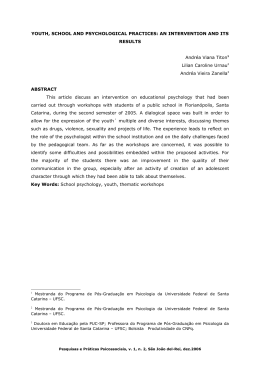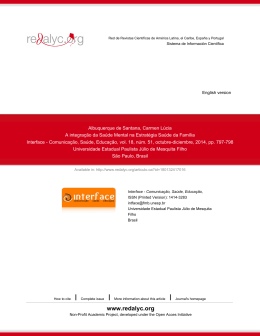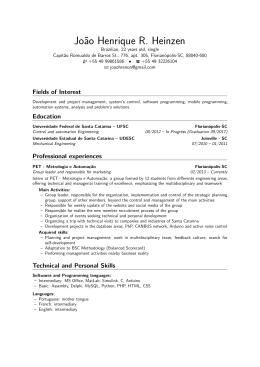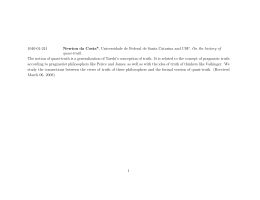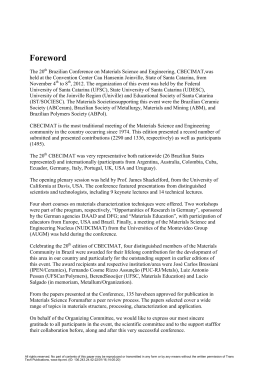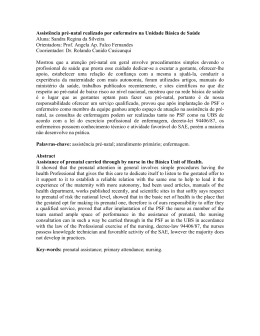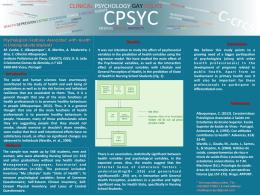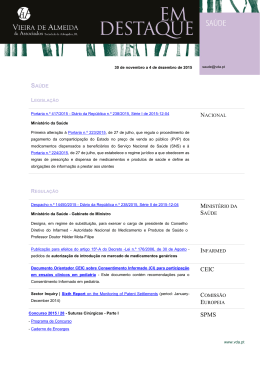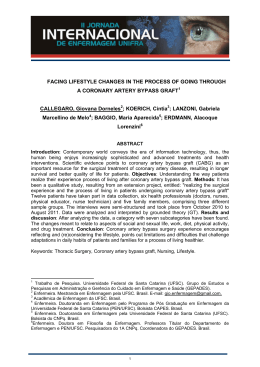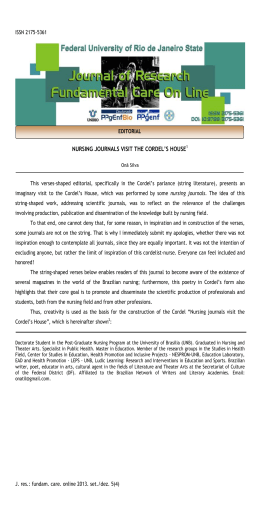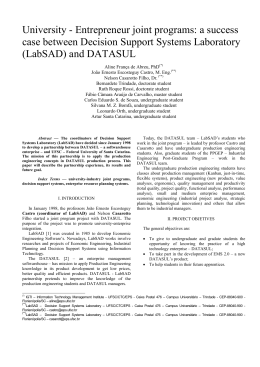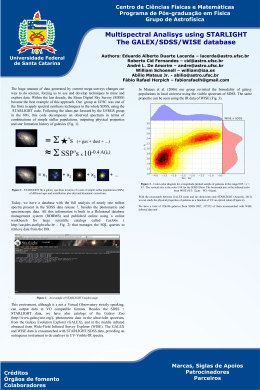EXPERIENCE REPORT: THE USE OF THE MAGUEREZ ARCH AS A METHODOLOGY FOR BUILDING A CRITICAL REFLECTIVE AND CREATIVE EDUCATIONAL PROCESS1 BARTH, Priscila Orlandi2; MASSAROLI, Aline3; CALLEGARO, Giovana Dorneles4; RAMOS, Flávia Regina Souza5; MARTINI, Jussara Gue6 ABSTRACT Introduction: Since the establishment of the Brazilian Unified Health System (SUS) in 1988, changes have been sought in the current health care model, modifying the profiles of professionals working in the system. Regarding the training of professionals as a key instrument for the consolidation of the System, it was established in 2004 the National Policy on Permanent Education in Health (Abbreviation in Portuguese - PNEPS). The PNEPS through the problematization of reality, aimed to the disclosure of critical transformation of professional practices and actions of health care. Objective: It was aimed to present an experience report conducted with the students of the Master’s Degree at Universidade Federal de Santa Catarina (UFSC) on PEH. Methods: The Maguerez Arch has been applied to build a critical reflective creative process. The Maguerez Arch served as a tool in facilitating this process, since this is worked from the problematization of reality. Results: Five key steps have been followed for the educational activity: observation of reality, the identification of key-points, theorizing, the hypothesis of solution, and application to reality. Conclusion: Throughout this activity, it was found that some professionals still have some difficulty in differentiating between the actions of PEH from continuing education, on the other hand, some emphasize the PEH as a strategy for transforming their actions. It is emphasized 1 Trabalho de Pesquisa. Universidade Federal de Santa Catarina (UFSC). Enfermeira. Especialista em Saúde Coletiva: Ênfase em Saúde da Família pela Universidade Regional Integrada do Alto Uruguai e das Missões (URI/FW). Mestranda em Enfermagem pela UFSC. Brasil. Bolsista CNPq. E-mail: [email protected] 3 Enfermeira. Mestranda em Enfermagem pela UFSC. Brasil. E-mail: [email protected] 4 Enfermeira. Mestranda em Enfermagem pela UFSC. Brasil. E-mail: [email protected]. 5 Doutora em Enfermagem. Professor Associado do Departamento de Enfermagem e do Programa de Pós-Graduação em Enfermagem (PEN) da Universidade Federal de Santa Catarina (UFSC). Pesquisadora CNPq. Santa Catarina, Brasil. E-mail: [email protected] 6 Enfermeira. Doutora em Educação. Docente do Departamento de Enfermagem da UFSC. 2 1 the need to discuss PEH in the spaces of teaching and learning, so that this can be deployed in the health services with a focus on local processing. Key - words: Continuing Education in Health, Maguerez Arch; Unified Health System 1. INTRODUCTION The establishment of the Unified Health System (SUS) in 1988, through the Federal Constitution of Brazil, established that health professionals should act according to the principles and guidelines established by the system, being responsible for setting guidelines for the formation of human resources for health. With the establishment of the Basic Operational Ruling for Human Resources in 2001, it has been consolidated the link between service quality and professional training focused on the NHS, emphasizing the establishment of curriculum guidelines, training of teachers for the NHS, the training of managers for breach of the biomedical model and the connection between teaching, research, and extension. (1) In 2004, it was formulated the National Policy on Permanent Education in Health (PNEPS) through Decree 198/04, which shows the continuing education of health professionals, focused on the needs of the local and the services which they are inserted. Learning at work must be significant and therefore should be held within the health services, incorporating the everyday activities of organizations and work. (2) In 2007, it was introduced the Ordinance Number 1,996/07 to reformulate PNEPS, emphasizing on decentralized actions of HPE, seeking to allow changes in management, care, training, and participation in work processes, enabling a multi-, interdisciplinary, and intersectional perspective. (3) Concerning such context, PEH aims to transform health care practices with a view to comprehensive care, based on social health needs fulfilling a strategic role in the dynamics of the operation of SUS. Before the changes in the health scenario, the following research aimed to report the development of a critical reflective creative process with students from the Master’s Degree of the Universidade Federal de Santa Catarina (UFSC) through the use of the Maguerez Arch. The topic proposed for the development of this process was the Permanent Education in Health (PEH). 2. METHODOLOGY 2 The development of the activity occurred in June 2011 at the Universidade Federal de Santa Catarina (UFSC) for the course on Nursing Education and Labor in the Master’s Degree Graduate Program of that university. The participants of this activity were the students enrolled in the course above, at a total of 17 students. In order to achieve the critical reflective creative educational process, it has been applied an active methodology as a theoretical referential, Maguerez Arch. The method of the arch was developed by Charles Maguerez and consists of the following steps: observation of reality, key-points, theory, possible solutions and application of reality. These steps provide participants with a critical reflection by questioning the reality on the topic being discussed. (4.5) These steps are described below, as were developed during the group discussion on PEH. 3. RESULTS AND DISCUSSION In order to perform the Maguerez Arch, we started from the observation of reality, by questioning the students about their reality, as it follows: What is your conception of Continuing Education in Health? What activities on Permanent Education in Health do you develop in your daily life? Is there a difference between Permanent Education in Health and Continued Education? At that moment the starting point is in the reality experienced by the student about the problem raised, the process of teaching and learning aspects that relate to the student observes carefully, expressing their perceptions and performs a reading of the syncretic reality. (4.5) The second step consists of the survey key-points, where it is selected what is relevant and essential for the representation of observed reality, identifying the variables that may contribute to understanding and resolving the problem. (4.5) At this stage , the students cited all the key issues they thought relevant, then there was the discussion of these points raised so that there was a consensus among participants about the key-points that were actually relevant. From this discussion, it has been created a final list of key points that represent the reality in question. The third stage of theorizing was the time when information needs to be analyzed, seeking explanations for the observed reality and understanding of key points, allowing some 3 conclusions that will enable the next step. (4.5) In order to help in this stage, papers were available allowing a greater theoretical support to the participants, contributing to the process of theorizing. The development has happened due to the exposure through dialogue between the students who coordinated the methodology of the Arch and the participating students through the use of audio visual and feature the participation of an expert teacher on the subject studied. The discussions focused on the differences in terms PEH and Continuing Education, whose students raised issues about the way and focus the development of each type of education. The fourth step is the formulation of hypotheses to solve problems, these should be built from the deep understanding of the problem, using creativity and originality of the students to seek new ways to resolve them throughout the development of this stage, attention should be paid to assess the possibility of applying the solution raised initially. (4,5) At this point there was a greater interaction between the involved participants, because when the ideas of possibility of hypotheses were raised by a participant, there was an intervention from others, contributing to the initial idea, allowing the refinement and polishing of this, making it even more interesting to the expected result. The assumptions for the initial questioning were transmitted to the implementation of PEH in their respective work environments, using meaningful and participatory approach to health professionals. The fifth step refers to the application of assumptions to reality, applying the selected viable solutions and the student learns to generalize what he had learned in order to use it in different situations, allowing him to switch from intellectual and return to his reality by applying a response to the problem raised, seeking to transform it in some way. (4.5) This step is viewed and experienced by students, at the time when they leave this discussion group and emerge again in their work environments to apply those hypotheses see how effective or not they are for their reality. 4. FINAL CONSIDERATIONS The use of the Maguerez Arch proved to be an excellent strategy for developing a process that sought a critical reflective and creative view. This theoretical ground was crucial since it allowed questioning the reality of the participants, making them feel as an essential part for the consolidation process. The discussion, the debate of ideas is strengthened throughout the process, and glimpsed the interaction and integration among the participants 4 involved in the group. This process allowed the exposure of the individual perception on the proposed topic, the debate between the different perceptions found and the formulation of a new perception of the group, as well as discussion on how the PEH is inserted in the daily lives of many professionals/students who made up the group that developed this process. In developing the educational process on critical reflective creative PEH, it has been highlighted the need for discussion on this topic in the educational field with its extension to the scope of activities and services of nursing and health. It is noteworthy that in the course of this process the students emphasized the importance of PEH in transforming their care practices, aiming at quality services to the population as well as the strengthening of relations between the team they belong to. 5. REFERENCES 1 Ministério da Saúde (BR). Políticas de Formação e Desenvolvimento para o SUS: Caminhos para a educação permanente em saúde. Secretaria de Gestão do Trabalho e da Educação na Saúde. Departamento de Gestão da Educação na Saúde. Brasília(DF) 2003 ago. 2 Ministério da Saúde (BR). Portaria Nº198/GM/MS. Institui a Política Nacional de Educação Permanente em Saúde como estratégia do Sistema Único de Saúde para a formação e o desenvolvimento de trabalhadores para o setor e dá outras providências. Brasília (DF) 2004 fev. 3 Ferraz F. Contexto e processo de desenvolvimento das Comissões Permanente de Integração Ensino Serviço: Perspectiva dos sujeitos sociais pautada na concepção dialógica de Freire. Universidade Federal de Santa Catarina. Tese de Doutorado. 2011. 4 Bordenave JDE; Pereira AM. Estratégias de ensino-aprendizagem. 24 ª ed. Petrópolis: Vozes; 2002. 5 Berbel NN. A problematização e a aprendizagem baseada em problemas: diferentes termos ou diferentes caminhos?. Interface: Comunicação, Saúde, Educação. 1998; 2(.2): 139-154. 5
Download
